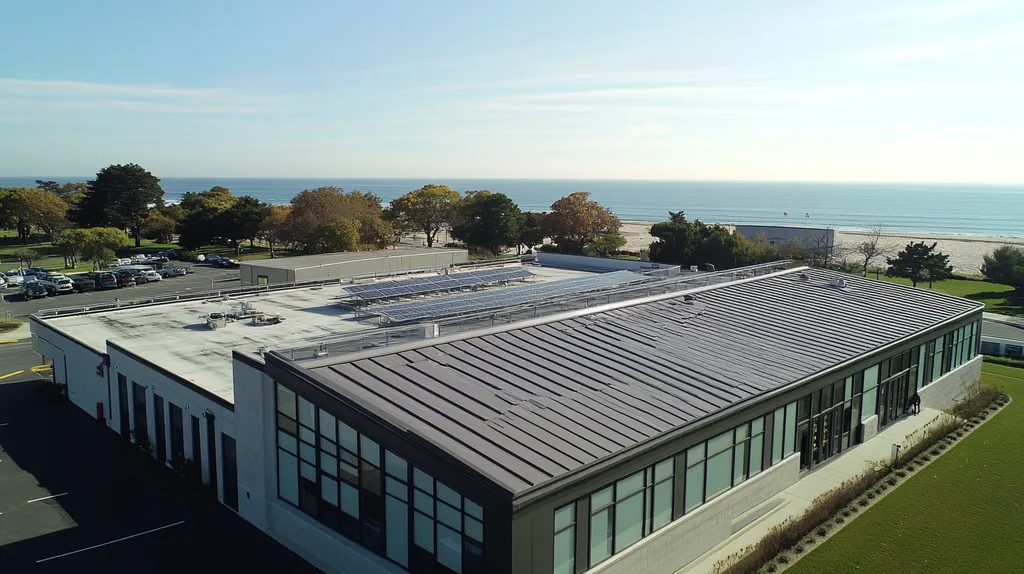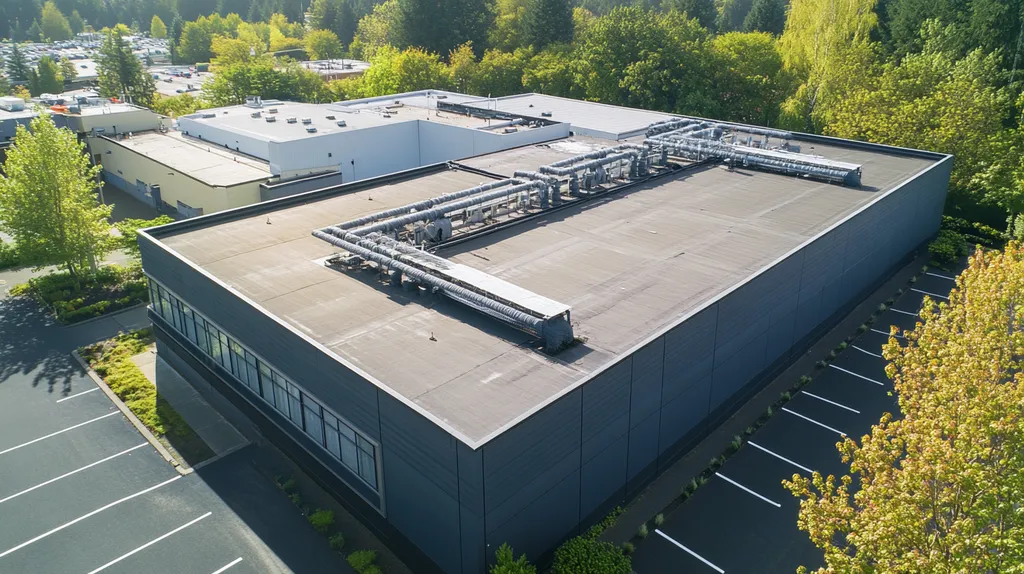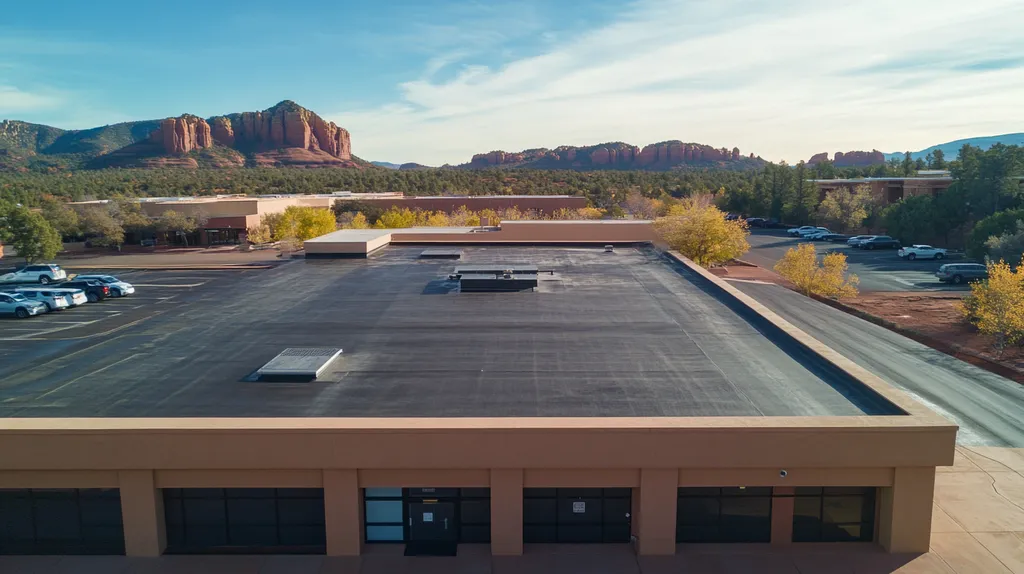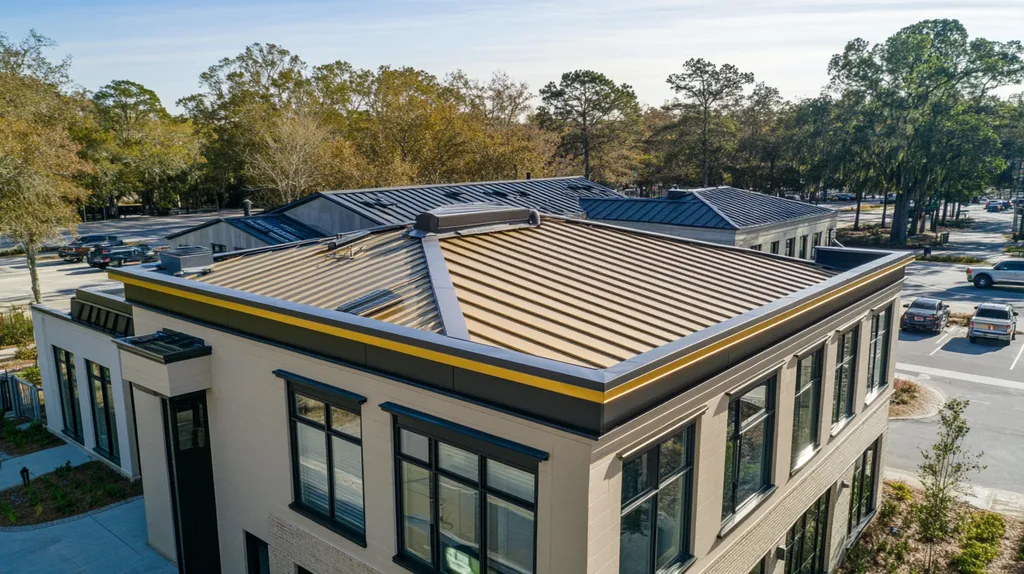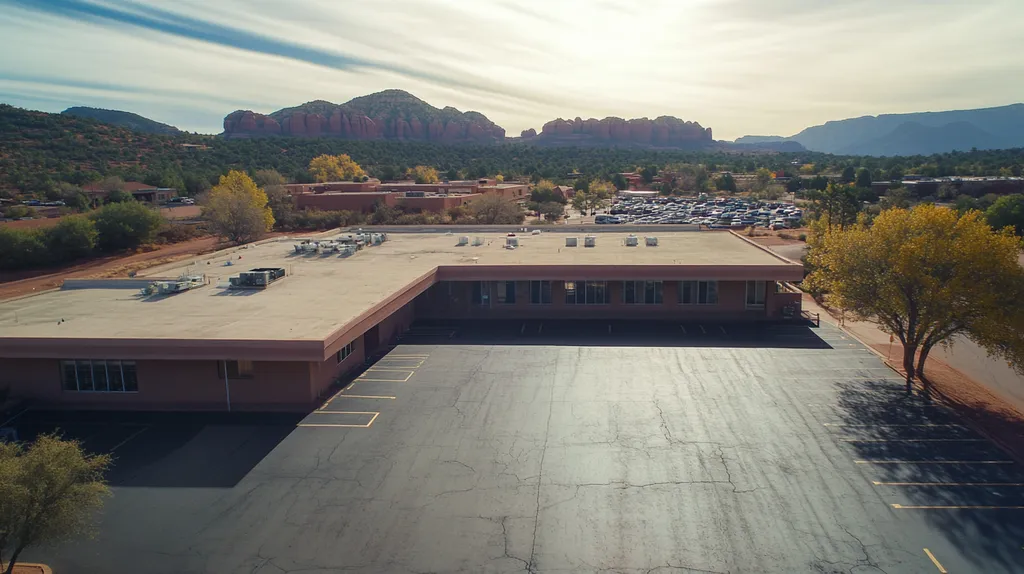In the commercial roofing industry, a startling 30% of warranty claims are denied due to insufficient maintenance documentation, resulting in millions in unexpected costs for property owners.
The relationship between regular maintenance and warranty coverage remains widely misunderstood, leading to costly misconceptions about inspection requirements and coverage terms.
This comprehensive analysis examines how maintenance practices directly influence warranty claims, debunking common myths while providing evidence-based strategies for protecting commercial roofing investments.
SECTION 1: COMMON MISCONCEPTIONS
A large number of property owners and facility managers hold onto misconceptions that can put their commercial roofing investments at serious risk. Alarmingly, a survey by the National Roofing Contractors Association revealed that nearly 30% of warranty claims are denied due to insufficient maintenance. These misunderstandings can lead to costly mistakes and increased vulnerability to damage. This section addresses three common misconceptions about roof maintenance and how they can negatively impact warranty claims.
Ignoring Maintenance Doesn’t Void Warranties
Many property owners mistakenly think that skipping regular roof maintenance won’t jeopardize their warranties. The truth is, most commercial roofing warranties explicitly require ongoing upkeep. If maintenance is neglected, owners risk having their warranties voided, leaving them responsible for expensive repairs.
Warranties are designed with the expectation that roofing systems will be properly cared for. Neglecting routine inspections and maintenance can lead to serious issues, and if damage does occur, manufacturers may deny claims based on lack of proper upkeep.
Regular maintenance not only ensures the roof remains intact but also generates important documentation for filing claims. Lacking proof of maintenance can result in property owners facing hefty repair costs that might otherwise be covered by their warranties.
Ultimately, the misconception that maintenance neglect won’t void warranties can have significant financial repercussions. Property owners must understand the critical nature of regular maintenance and the terms of their warranties to protect their investments.
All Warranties Cover Same Issues
Another common fallacy is the belief that all commercial roofing warranties provide identical coverage for damages. In reality, warranties can vary greatly in their terms, duration, and the types of damage they encompass. Recognizing these differences is crucial for safeguarding investments.
For example, some warranties may only address material defects, while others could also cover workmanship problems. Selecting a low-cost warranty might lead to inadequate coverage, exposing property owners to higher financial risks if damage occurs.
Additionally, many warranties contain exclusions related to lack of maintenance or not following specified guidelines. Being well-informed about what is included in a warranty is just as vital as committing to regular inspections and cleanings. Misunderstanding warranty specifics can result in denied claims when it matters most.
It is essential for property owners to thoroughly review their warranty terms. The differences can mean the distinction between a costly repair project and a claim that’s fully covered.
No Need for Professional Inspections
Some property owners believe they can handle roof maintenance on their own without seeking professional assistance. This misconception risks compromising the roof’s integrity, as it overlooks the benefits that come with expert inspections. Skilled professionals can detect early signs of wear, leaks, or vulnerabilities that might escape the untrained eye.
For example, professionals are trained to identify subtle indicators of potential failures that could lead to significant issues down the road. Routine inspections conducted by qualified experts not only ensure a roof’s performance but also help maintain compliance with warranty requirements.
Moreover, professional inspectors generate documented reports that are crucial when submitting warranty claims. Without this evidence, property owners could struggle to provide a convincing narrative about their roof’s maintenance history to manufacturers.
In summary, relying solely on DIY inspections as a stand-in for professional evaluations is a risky strategy. Engaging experts for regular inspections can enhance the roof’s lifespan and uphold warranty protections, safeguarding property owners from unexpected costs in the future.
SECTION 2: PRACTICAL IMPLICATIONS
The regular maintenance of commercial roofs goes beyond being just a best practice; it’s essential for ensuring warranty claims are valid. Studies reveal that nearly 70% of warranty claims are denied due to insufficient maintenance documentation. This shocking statistic compels property owners and facility managers to reassess their maintenance strategies. In this section, the implications of maintenance on warranty validity, the consequences of neglect, and the importance of scheduled inspections will be highlighted.
Impact on Warranty Validity
Many roof warranties come with specific requirements for regular maintenance checks. Failing to adhere to these guidelines can lead property owners to face denied claims. Numerous manufacturers explicitly state that without solid maintenance records, warranty validation is at risk.
When problems arise, the lack of documented maintenance can have severe financial repercussions. Property managers should implement a strong record-keeping system to document maintenance activities, ensuring warranties remain valid and unexpected repair costs are kept to a minimum.
For instance, if a roof leak occurs and an owner cannot demonstrate routine inspections and upkeep, the manufacturer might reject the claim. This scenario illustrates the significance of adhering to industry standards to protect their investments.
Furthermore, certain warranties may provide broader coverage for damages if consistent maintenance is evidenced. This means that diligent upkeep not only protects warranty claims but could also expand coverage, offering added peace of mind.
Consequences of Neglecting Maintenance
Neglecting regular roof maintenance can result in dire and expensive consequences. Minor issues, if not addressed, can escalate into significant repairs affecting a facility’s daily operations. For example, a single cracked seam can lead to water leakage, which may cause extensive interior damage over time.
In addition to immediate repair costs, neglect can lead to structural weaknesses that compromise the overall safety of the building. This deterioration negatively impacts not only aesthetics but can also lower property value. Property owners must understand that proactive maintenance is vital for protecting their investments.
Moreover, frequent leaks or failures necessitate repeated repairs, leading to operational disruptions. Every repair can result in downtime, causing businesses to lose productivity and revenue. By maintaining a regular upkeep schedule, disruptions can be minimized.
Neglecting maintenance also poses compliance risks. A compromised roof may fail to meet building codes, which could expose property owners to legal liabilities and potential fines. These implications emphasize that routine maintenance is crucial not just for upkeep, but for safeguarding the entire facility.
Importance of Scheduled Inspections
Scheduled inspections are essential for prolonging the life of a commercial roof. Experts recommend conducting at least two comprehensive inspections each year, ideally in the spring and fall. These assessments can uncover potential problems before they escalate into costly repairs.
Regular inspections help maintain warranty claims while also presenting an opportunity to gauge the roof’s overall condition. This proactive approach allows facility managers to address wear and tear early, thus extending the roof’s lifespan.
Moreover, meticulous documentation of these inspections is crucial. Maintaining a thorough inspection log serves as important evidence if a warranty claim is ever necessary. This documentation demonstrates compliance with warranty conditions and reflects due diligence in roof care.
Inspections can be carried out by both internal staff and external roofing professionals to ensure a thorough review. Hiring trained professionals can reveal hidden issues that may be missed by the untrained eye. Investing in expert inspections brings added peace of mind and reduces the risk of unexpected expenses down the road.
SECTION 3: COST OF MISINFORMATION
When property owners and facility managers underestimate the value of regular roof maintenance, they expose themselves to perilous financial consequences. A staggering study indicates that nearly 60% of commercial roof warranty claims are denied due to maintenance oversights. Understanding how misinformation about roof care can lead to significant costs is essential for preserving investments and ensuring business continuity.
Financial Consequences of Voided Warranties
Voiding a warranty can lead to crippling financial repercussions. When a warranty becomes invalid, property owners are left to foot the bill for unexpected repairs. For instance, a minor roof leak can snowball into thousands of dollars in damage if maintenance is neglected, forcing building owners to scramble for funds to cover the repairs.
Moreover, many warranties require routine inspections at defined intervals. Failing to adhere to these stipulations can result in automatic denial of claims, leaving property managers vulnerable to significant financial losses.
Property owners should understand that proactive maintenance not only safeguards the roof but also maintains warranty coverage. Investing in regular service can lead to long-term savings by reducing the risk of unexpected repair costs.
A lack of understanding regarding warranty requirements can create not only financial burdens but also operational disruptions that negatively impact a business’s profitability.
Uncovered Repair Costs and Downtime
As roofing systems start to fail, the costs of uncovered repairs can escalate dramatically. Without regular maintenance, small problems can rapidly develop into major issues that demand extensive repairs. The fallout from such repairs often results in prolonged downtime for businesses, disrupting operations and straining financial resources.
Consider a commercial facility that suddenly experiences a roof leak; they may need to halt production or evacuate employees for safety. Such interruptions can lead to revenue loss and erode customer trust as operations are compromised by unforeseen maintenance issues.
Strategic maintenance helps avert these scenarios by addressing minor concerns before they escalate. Ensuring consistent care of roofs allows for uninterrupted workflow, minimizing costly interruptions.
By embracing a routine maintenance mentality, property owners not only protect financial resources but also preserve business operations, enabling timely and effective responses to roofing issues.
Long-Term Effects on Roof Lifespan
The lifespan of a commercial roof is profoundly influenced by its maintenance history. Research shows that regular upkeep can extend a roof’s life by 30% or more. In contrast, neglecting maintenance accelerates deterioration, often leading to premature roof replacement.
Every component of a roof, from membranes to drainage systems, needs regular attention for optimal performance. For instance, debris accumulation in gutters can lead to overflow and damage roofing materials. Without proactive cleaning and checks, these issues can worsen, ultimately resulting in roof failure.
Property owners should recognize that investing in regular inspections enhances the longevity of their roofing systems, translating into significant savings on repair and replacement costs over time.
Awareness of the long-term implications of proper maintenance can motivate property owners to adopt proactive strategies, strengthening their roofing investments and ensuring optimal roof functionality for years to come.
SECTION 4: REALITY CHECK
Understanding commercial roofing warranties is vital for property owners and facility managers. Many mistakenly believe that these warranties provide complete protection against all issues. Alarmingly, over 40% of roof warranty claims are denied simply due to missed maintenance obligations. This section clarifies what warranties typically cover, explains mandatory maintenance requirements, and highlights common exclusions and limitations that could jeopardize claims.
What Warranties Actually Cover
Commercial roofing warranties can be intricate and often lead to confusion. Typically, they cover defects in materials and workmanship for a specific timeframe. Some warranties may extend limited coverage against leaks and performance issues, but the extent of this coverage can vary significantly across manufacturers.
Some warranties offer substantial protection, while others provide minimal coverage, leaving property owners vulnerable. Thoroughly reviewing warranty documents is crucial to understand the exact protections in place.
It’s essential to note that a warranty does not relieve property owners of their responsibility to maintain the roof. Regular inspections and diligent maintenance are key to keeping warranties valid.
When proper maintenance is overlooked, warranties can easily become void, meaning property owners could face unexpected repair costs. Staying proactive and knowledgeable about warranty specifics is a strategy that can lead to significant time and cost savings.
Mandatory Maintenance Requirements
Many manufacturers require mandatory maintenance as a condition of their warranty coverage. This typically includes routine inspections and maintenance checks at least twice a year. Such requirements are essential for maintaining not only coverage but also the roof’s overall performance.
If a roof is not regularly inspected as stipulated, any damage may not be covered during the warranty period. This reality emphasizes the need for property owners to invest time and resources into proper roof care.
Accurate documentation of all maintenance activities is equally important. Property owners should keep detailed records to provide evidence of compliance when filing claims. Neglecting this can threaten the validity of future warranty claims.
In summary, disregarding mandatory maintenance poses serious risks, potentially leading to significant financial liabilities. Diligence in inspections safeguards both the roof’s integrity and the property owner’s investment.
Exclusions and Limitations
Although warranties provide important protections, they often come with numerous exclusions and limitations. Common exclusions include damage from severe weather, insufficient drainage, or improper installation practices.
Many warranties explicitly state that they will not cover damages resulting from natural disasters, such as hail or flooding, unless additional riders are purchased. This limitation can leave property owners exposed to significant risks.
Additionally, warranties may have limitations regarding coverage duration. Often, they provide comprehensive protection for only a set number of years, after which coverage may decrease. This can lead to confusion about when protections actually expire.
Recognizing these exclusions and limitations is crucial for property owners. By being aware, they can proactively take measures to ensure optimal protection for their roofs and financial security against unforeseen circumstances.
SECTION 5: EVIDENCE-BASED ALTERNATIVES
Neglecting routine maintenance can precipitate costly roofing failures and lead to substantial financial losses for property owners. Studies indicate that businesses lacking regular roof inspections may face repair costs exceeding 50% of their roof’s value. To safeguard investments and ensure roof longevity, facility managers must prioritize maintenance. This section highlights the numerous benefits of regular inspections, actionable maintenance strategies, and the critical need for compliance with warranty terms.
Benefits of Regular Roof Inspections
Conducting regular roof inspections is vital for the early identification of problems before they escalate into major repairs. Research shows that proactive inspections can decrease emergency repair costs by up to 30%. By quickly addressing leaks, seam failures, and membrane wear, property owners can save substantial amounts over the roof’s lifespan.
Moreover, these inspections generate vital documentation that becomes essential when filing warranty claims. Having a well-documented maintenance history facilitates faster claims processing and ensures clearer communication with manufacturers, thereby strengthening the property owner’s position.
Inspections also allow for a thorough assessment of roofing materials. Gaining insight into the condition of membranes or coatings enables informed decisions regarding future maintenance or upgrades, enhancing the roof’s performance and longevity.
Ultimately, regular inspections promote a culture of accountability and vigilance within facilities management, driving sustained roof performance and protecting lengthy investment horizons.
Effective Maintenance Strategies
Developing a comprehensive maintenance strategy is crucial for maximizing the lifespan of a roof. Industry guidelines recommend scheduling at least two inspections and maintenance visits annually. This regular engagement enables routine cleaning of debris and thorough examinations of critical roof components.
Incorporating preventative measures, such as sealing seams and applying reflective coatings, significantly boosts the roof’s resilience against environmental stresses. For instance, reflective coatings can help lessen the impact of thermal expansion and contraction, further prolonging the roof’s life.
Training facility staff on basic maintenance tasks ensures that minor issues are addressed before they escalate into larger problems. Maintenance logs generated during inspections provide a roadmap for future actions, streamlining management efforts and improving accountability.
Additionally, leveraging technology, such as drones for aerial inspections, can enhance the efficiency and accuracy of assessments while reducing labor costs, making maintenance both effective and cost-efficient.
Compliance with Warranty Terms
Understanding and adhering to warranty terms is critical for maintaining roofing integrity. Many warranties stipulate regular inspections and documentation of maintenance to remain in effect. Non-compliance can void warranties and expose property owners to significant repair costs.
It is essential to collaborate with roofing contractors who are well-versed in warranty stipulations, as they can guide compliance effectively. Maintaining detailed records of inspections, repairs, and maintenance efforts is paramount to future claims.
Moreover, taking advantage of manufacturer recommendations during maintenance can yield additional advantages. Many manufacturers provide maintenance programs that ensure compliance while offering updates based on the latest product knowledge.
Finally, property owners can diminish risks by establishing clear communication channels with manufacturers to clarify warranty terms and keep compliance procedures up to date.
SECTION 6: TEST AND VERIFY
Testing and verifying the condition of a commercial roof is essential for preserving its integrity and maximizing warranty benefits. Recent studies indicate that a staggering 80% of warranty claims are denied due to insufficient maintenance documentation and lack of regular inspections. Routine inspections are not only beneficial; they are a vital component of warranty compliance that can help property owners avoid costly repairs down the line.
Conducting Annual or Biannual Inspections
Implementing annual or biannual inspections can catch minor issues before they escalate into expensive repairs. Scheduled assessments allow for early identification of leaks, surface damage, and drainage problems, which, if unchecked, could compromise the roof’s structural integrity. For instance, a seemingly small leak could quickly evolve into extensive water damage, significantly boosting repair expenses.
Property owners should look to engage professional roofing contractors who possess both the expertise and familiarity with their specific roofing systems. This specialized knowledge enables accurate assessments and appropriate repair recommendations. Additionally, many manufacturers mandate these regular inspections as part of their warranty agreements.
Thorough documentation of the findings and recommendations from these inspections is critical. Such records can provide essential evidence during any warranty claims process. Inspections should delve into visible damage as well as underlying issues that could accelerate wear over time.
A proactive inspection schedule aligns seamlessly with a property owner’s long-term maintenance strategy, ensuring optimal roof performance and longevity. Ultimately, regular inspections enhance not only the lifespan of the roof but also reflect positively on the overall management of the property.
Documenting Maintenance and Repairs
Keeping comprehensive records of all maintenance activities and repairs is paramount for validating roof warranty claims. Clear and detailed documentation acts as proof that the roof has been properly maintained according to warranty stipulations throughout its lifespan.
Each maintenance log should contain dates, a description of the work performed, and any materials used. This level of detail creates a transparent history that can help mitigate disputes over claims in the event repairs are required due to a manufacturer’s defect.
Moreover, opting for a digital maintenance management system can greatly simplify the process of tracking and organizing these records. Many property managers find that a well-maintained digital log also promotes better communication with contractors, ensuring accuracy and accessibility of all maintenance records.
A well-documented maintenance history enriches the warranty claims process and serves as an ongoing reminder for property owners to remain vigilant about future maintenance needs. Such records facilitate prioritizing repairs based on the roof’s condition, effectively managing operational costs.
Verifying Contractor Approval and Compliance
It is crucial for property owners to ensure that all maintenance and repairs are conducted by approved contractors. Most manufacturers set specific criteria regarding who is authorized to work on their roofing systems, and utilizing unapproved contractors can invalidate warranties.
Before hiring a contractor, property owners should verify their credentials, including licensing, insurance, and manufacturer approval. This important step helps maintain warranty validity and ensures repairs are performed correctly, adhering to industry standards.
Moreover, ongoing training in the latest roofing technologies and techniques is essential for contractors. Regular training guarantees compliance with current safety and quality standards, thereby protecting the roof’s integrity.
Implementing a checklist that includes verifying contractor credentials can streamline the hiring process. This diligence not only safeguards the investment but also ensures the roofing system remains in optimal condition, maximizing the owner’s return on investment.
The Bottom Line
With 30% of commercial roof warranty claims being denied due to inadequate maintenance documentation, the stakes for property owners have never been higher.
Regular maintenance isn’t just about preserving roof integrity—it’s about protecting substantial financial investments through valid warranty coverage.
The evidence is clear: properties with documented maintenance programs experience 50% fewer emergency repairs and maintain their warranty protection.
Moving forward, facility managers must prioritize scheduled inspections, maintain detailed records, and work exclusively with approved contractors to ensure warranty compliance.
The cost of ignoring these fundamentals—potentially hundreds of thousands in uncovered repairs—far outweighs the investment in proper maintenance protocols.
FREQUENTLY ASKED QUESTIONS
Q. Does neglecting maintenance void my commercial roof warranty?
A. Yes, many warranties explicitly require regular maintenance. Failing to conduct it can result in voided warranties, making property owners responsible for costly repairs. Proper upkeep documentations are essential to validate warranty claims and prevent unexpected expenses.
Q. How does regular maintenance influence warranty validity for industrial roofs?
A. Regular maintenance is crucial for maintaining warranty validity. Many warranties state that consistent upkeep is required; otherwise, claims may be denied. Keeping comprehensive records of inspections and maintenance activities strengthens the case for any warranty claims.
Q. What are the financial consequences of ignoring commercial roof maintenance?
A. Ignoring maintenance can lead to substantial repair costs if warranty claims are denied. Furthermore, minor issues may evolve into major problems, potentially disrupting business operations and eroding profits. Proactive maintenance is essential to safeguard investments and minimize financial risks.
Q. What should I know about mandatory maintenance requirements for commercial roofs?
A. Many warranties include mandatory maintenance requirements, usually necessitating inspections at least twice yearly. Failing to comply can jeopardize warranty coverage, exposing property owners to unanticipated costs. Regular inspections and proper documentation help ensure compliance and protect roofing investments.
Q. What are common exclusions in commercial roofing warranties?
A. Exclusions often include damage from severe weather events or improper installation. Many warranties define specific duration limits and reduce coverage over time. Being aware of these exclusions is crucial to make informed decisions about managing roofing risks effectively.
Q. How can I verify the qualifications of my commercial roofing contractor?
A. Verify your contractor’s credentials by checking their licensing, insurance, and manufacturer approvals. Ensuring they have the necessary qualifications to perform work on your roofing system protects warranty coverage. It’s crucial for the integrity of your roof and compliance with industry standards.
Q. How often should I conduct inspections on my commercial roof?
A. It is recommended to conduct inspections at least twice a year, ideally in spring and fall. Regular assessments help identify potential problems early, ensuring that maintenance is performed timely and that warranty requirements are met. This proactive approach safeguards your investment.


